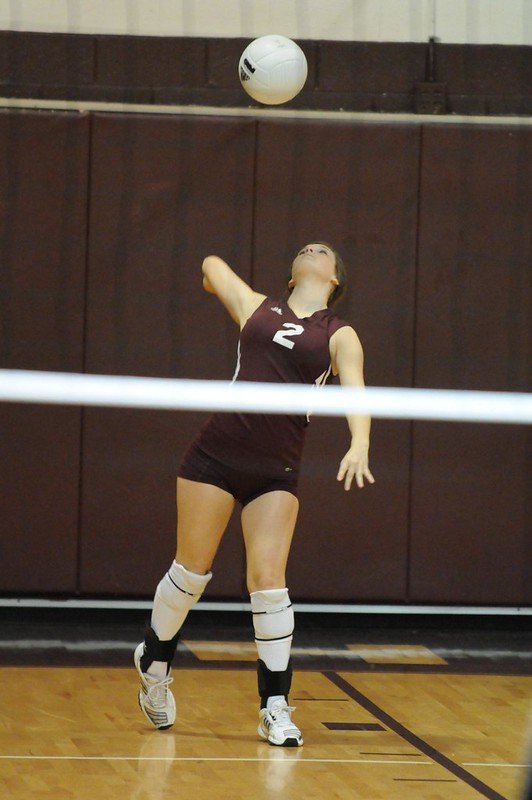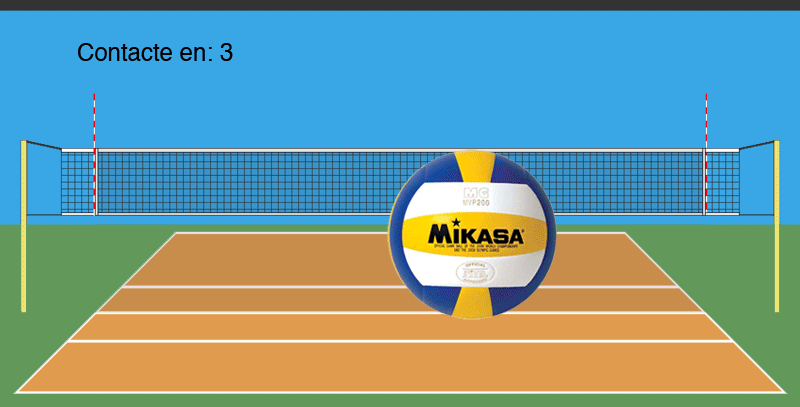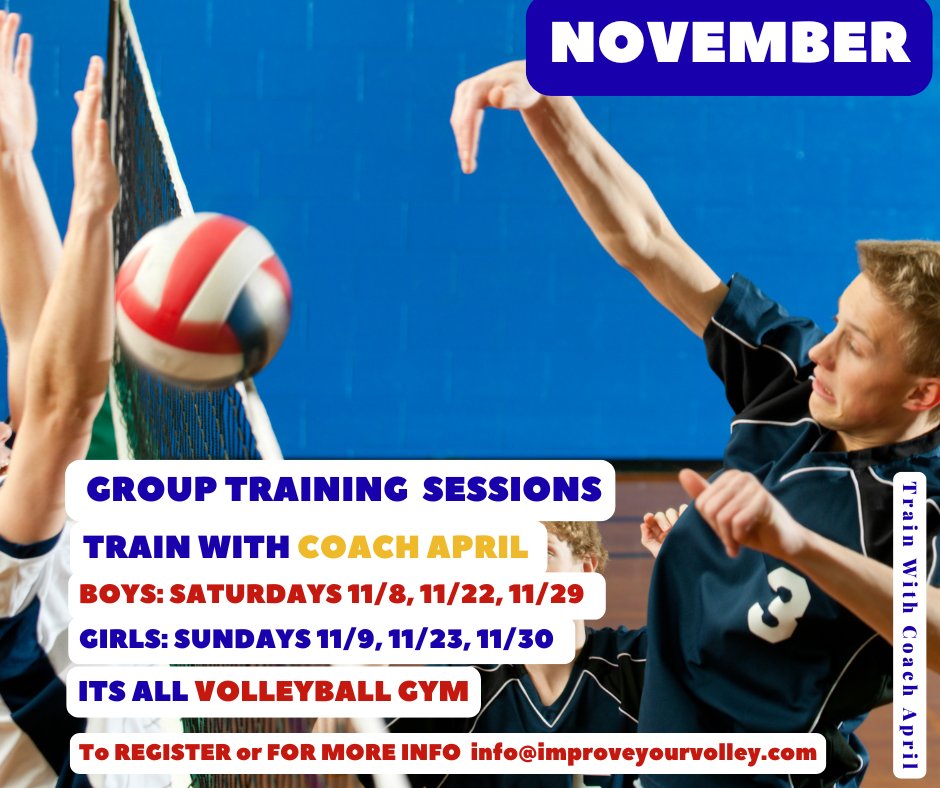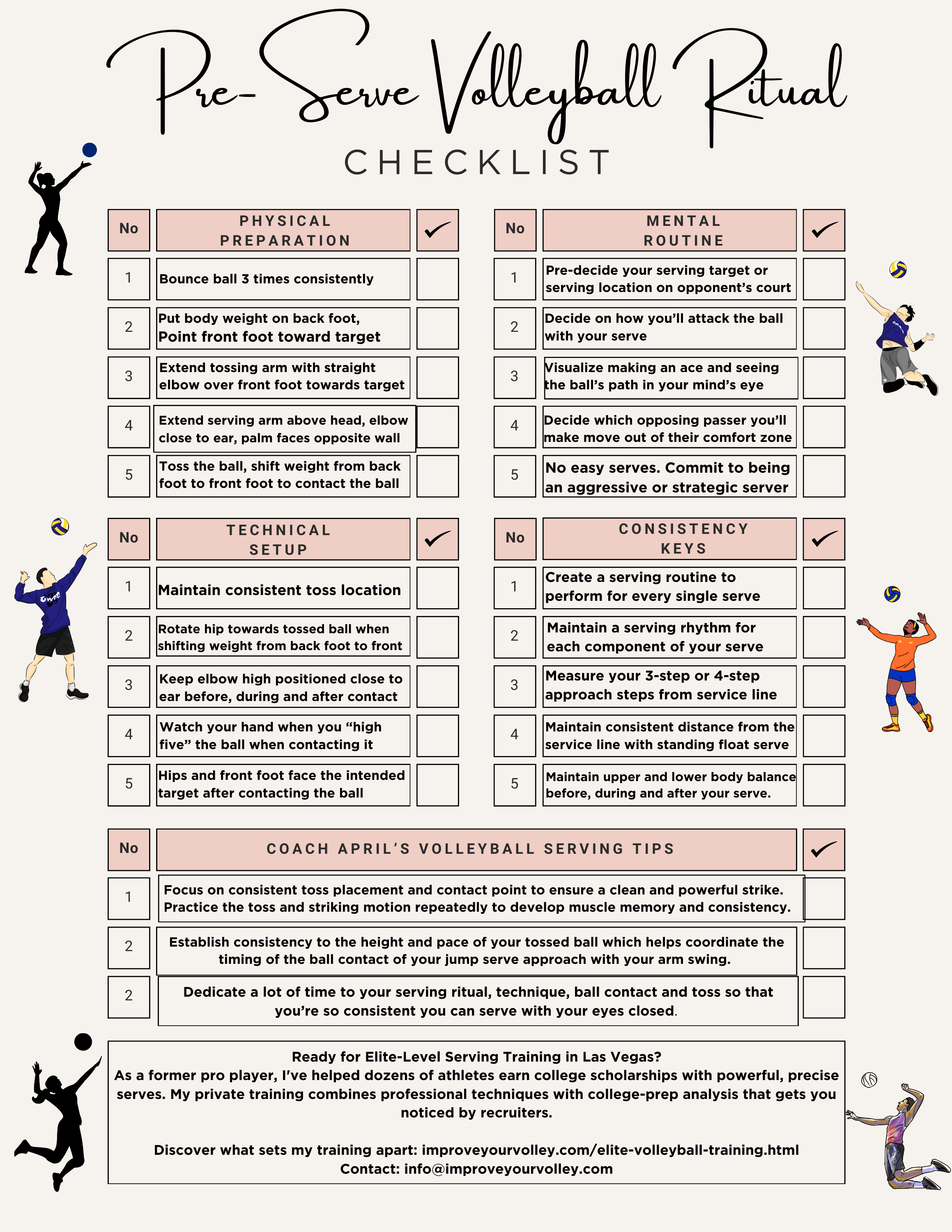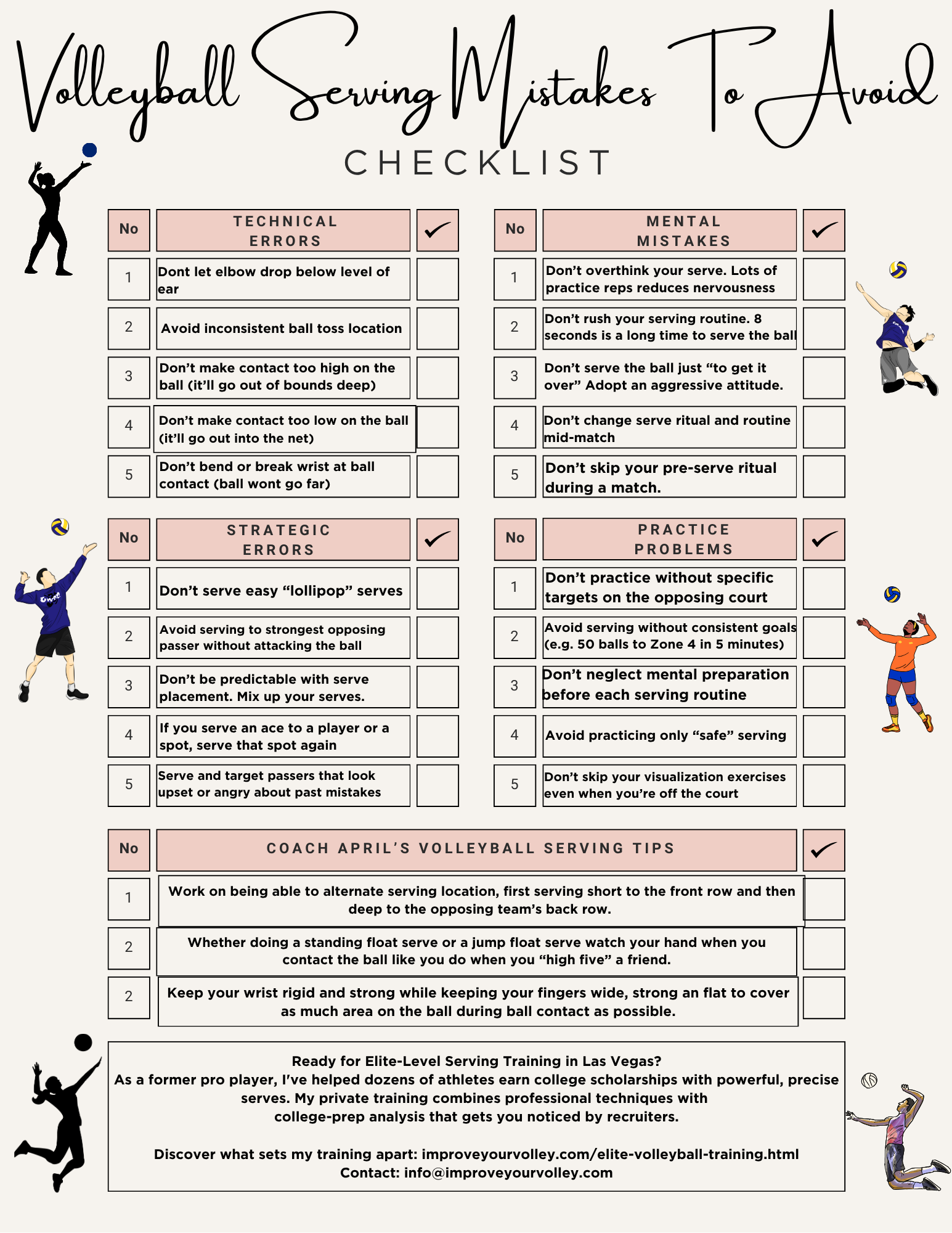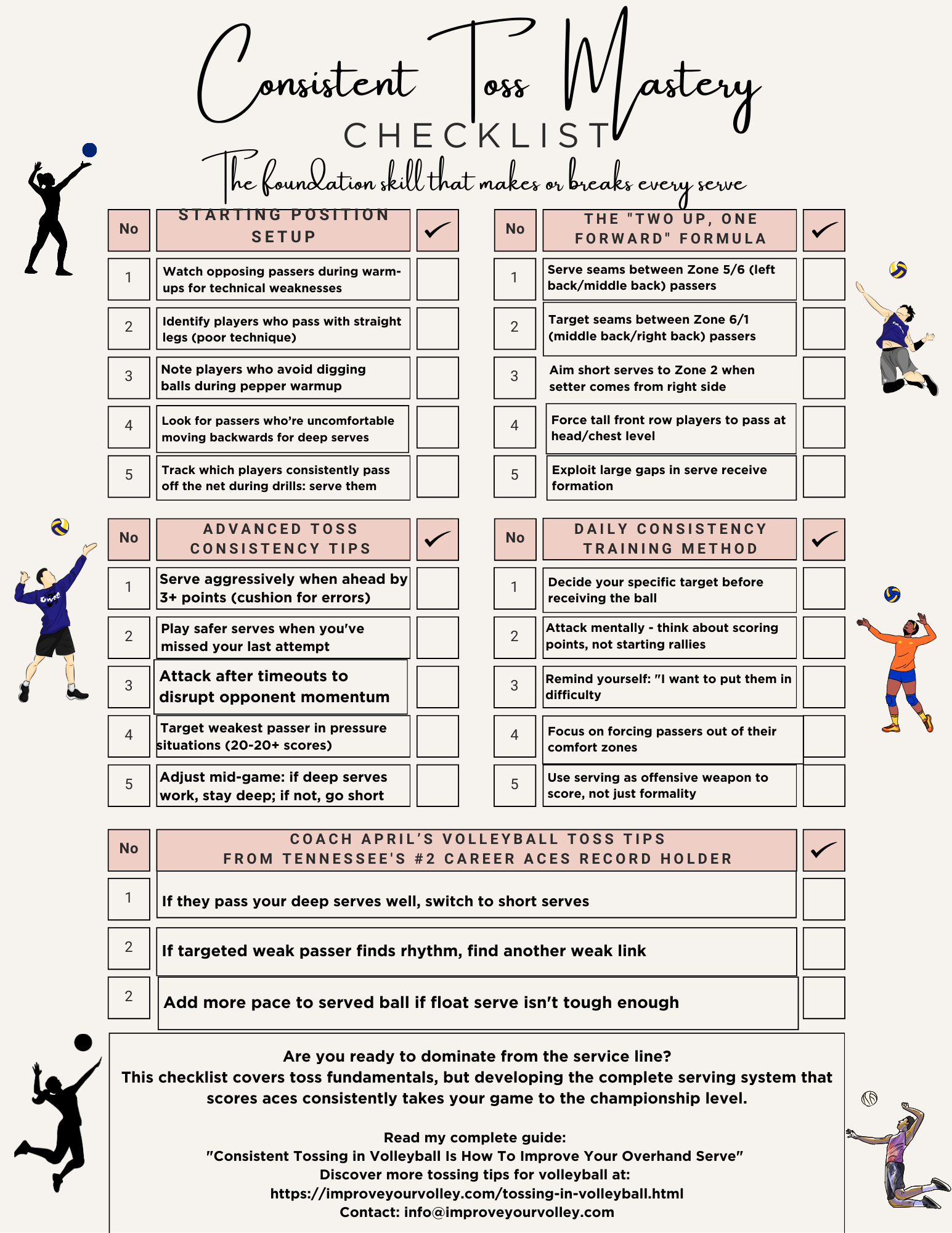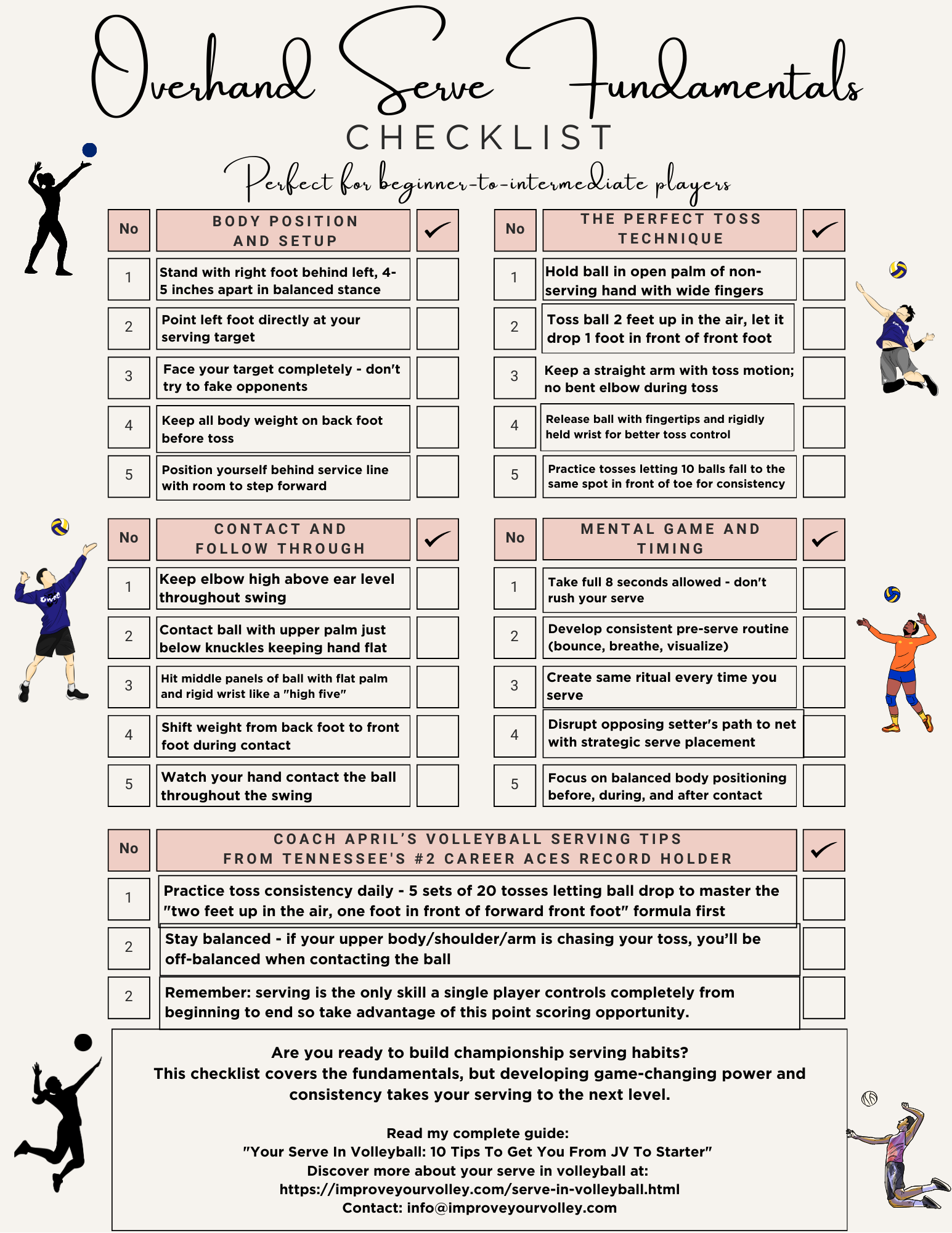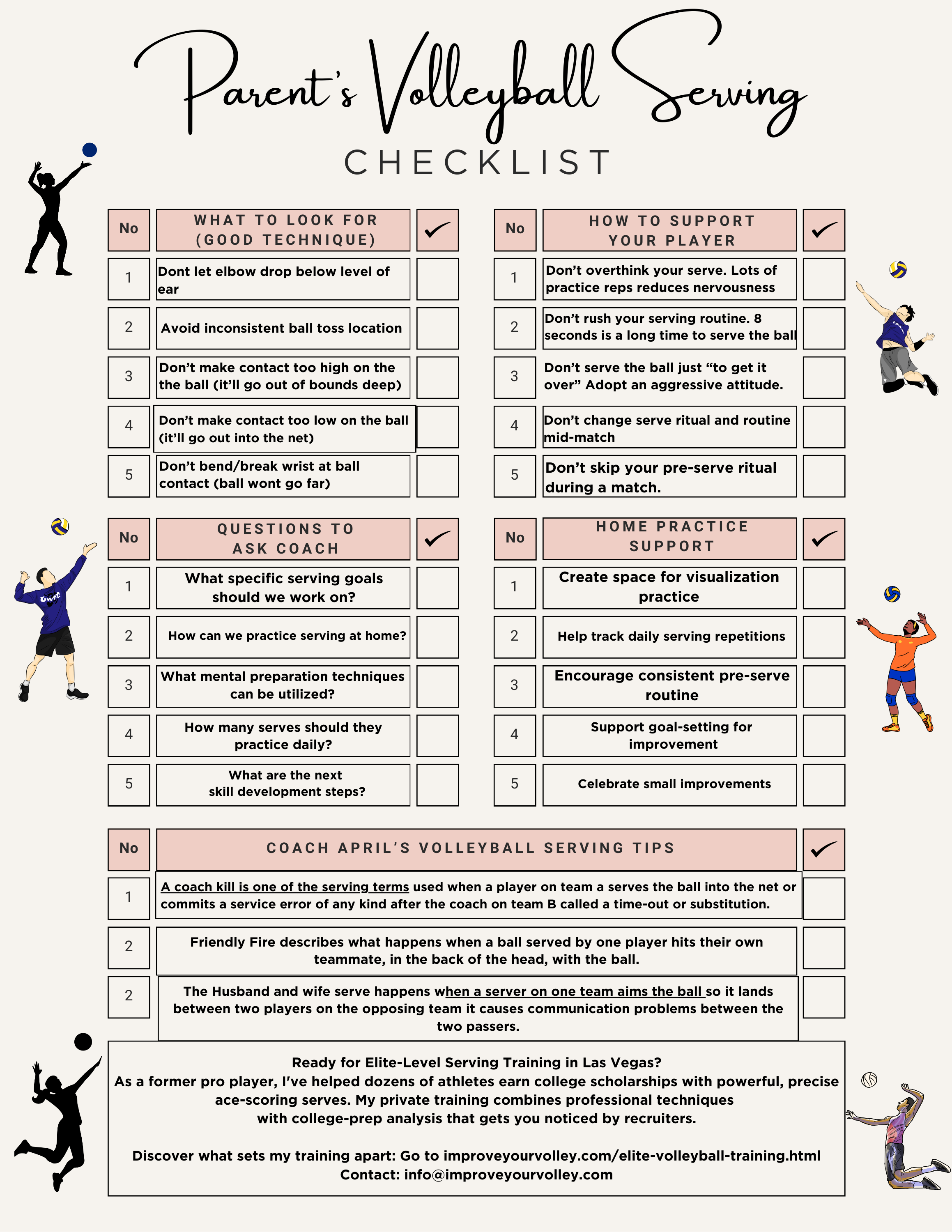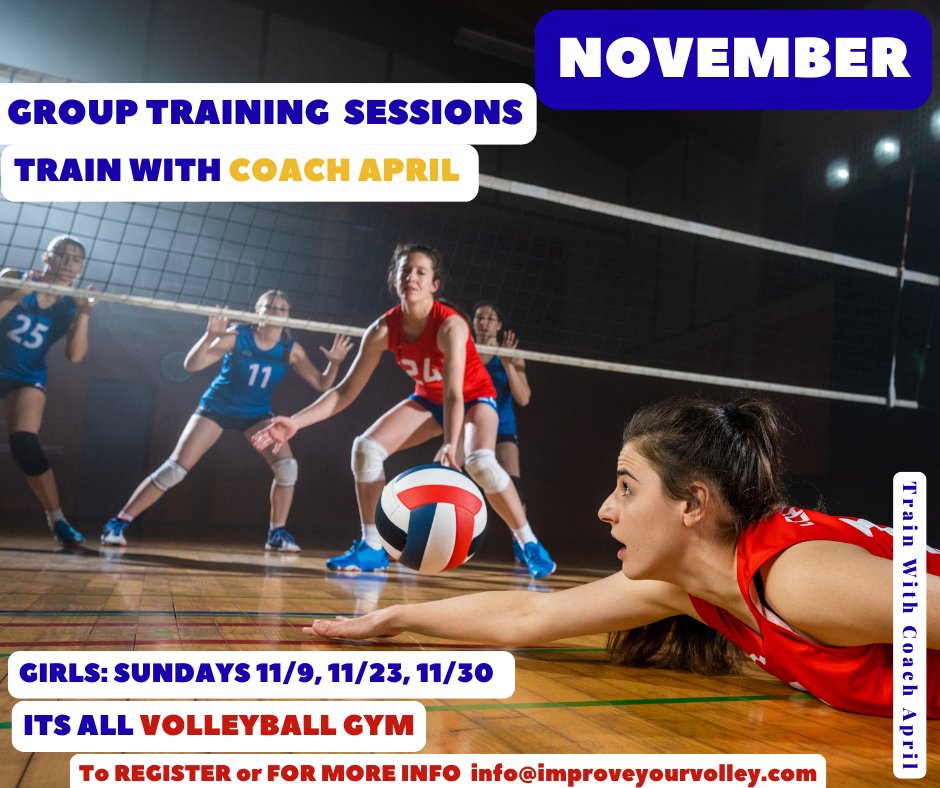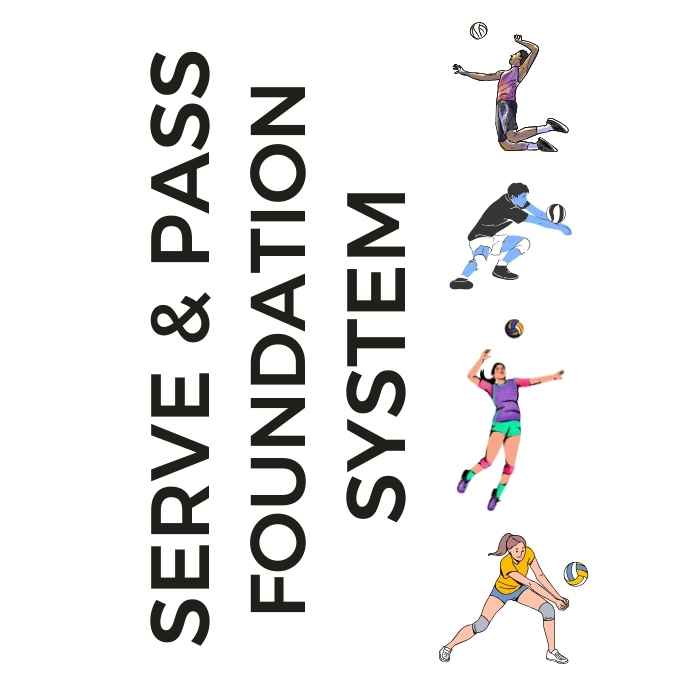
Serve + Pass Foundation System: The Complete Skills Arsenal The two-skill mastery system that transforms inconsistent players into the athletes coaches build their lineups around. Stop Struggling With The Two Most Important Skills In Volleyball!
- Improve Your Volleyball with Coach April
- Volleyball Checklist
- Volleyball Slang For Serving Situations
The Volleyball Moms' Guide to Volleyball Slang For Serving Situations
Decode the language of volleyball slang for serving situations with my mom-focused list of terms like ace, floater, jump serve, foot fault and let serve.
Dear volleyball moms, as your child embarks on their volleyball journey, you may find yourself navigating a new world of terminology and slang.
This will make you cry! An injured player is given the chance to serve a ball on game point during the last point of the last game of the team's regular season. And all the muscle memory and serving reps done in practice work in her favor...watch how she helps her team win their match...with a well-placed standing float serve...ace!
In this article, I'll break down the most common volleyball slang for serving situations, helping you understand the language of the court and become a more informed volleyball mom.
Whether your child is a beginner just starting out or has been playing for a couple of years, this guide will equip you with the knowledge to support their growth and communicate effectively with coaches and other volleyball parents.
"Ace": The Serving Slang Term Every Volleyball Mom Should Know
As a volleyball mom, you'll quickly learn that an "ace" is the ultimate goal of every server.
Ella Serves An Ace Between The Left Back and Middle Back Passers
An ace is a point won 100% completely through the server's skill and it's usually a moment of pride for both the player and their parents when its done successfully.
Unlike other skills, that need the assistance of two or more players working together in order to score a point, no one else helps them serve, no one else helps them get the ball over the net after the referee blows the whistle to start the play.
As a mom it can be nerve wracking watching your beginner player learn how to serve at first but when they learn how the serving skill works for them, then they keep practicing it at home and with their team during practices so they can handle the pressure of getting the ball over the net...completely by themselves.
So, when you hear this term used by people and fans and family shouting it or saying it in the stands, don't be surprised to see the team starting to cheer and give out high-fives...when your son or daughter's team...scores an "ace."!
"Floater" and "Jump Serve": Serving Slang for Different Techniques
As your child progresses and hopefully improves in volleyball, you may hear their coach discussing different serving techniques, such as the "floater" and the "jump serve."
A "floater" serve is a type of serve made when the middle of your hand contacts the middle panels of the ball in a way that produces minimal to no spin on the ball, causing the ball to wobble, float and move unpredictably through the air as it makes its way across the net, making it challenging for the opposing team to pass.
On the other hand, a jump serve involves a more advanced serving technique where the server, before they start their serve, backs up three to four steps behind the service line before taking a three-step or four step spike approach that propels them in the air before they contact the ball just before crossing the service line when they land at a higher contact point, resulting in a more powerful serve.
Understanding the various volleyball slang for serving situations should help you appreciate the variety of serves your child will be learning and why and where they will serve for the strategic decisions made by their coach.
"Let Serve" and "Foot Fault": Volleyball Rules and Slang For Serving Situations
You should learn these two important serving terms related to volleyball rules are called the "let serve" and the "foot fault."
Volleyball Slang For Serving Situations:
What's a "let" serve?
It's important to know that a "let serve" is considered legal in modern volleyball.
This rule was changed so that play would continue even if the ball hit the net when served because originally if a player served the ball and it touched the net, that was considered a foul and the referee would blow their whistle, stop play and award the ball to the opposing team so they could serve.
Volleyball Slang For Serving Situations:
What's a "foot fault"?
However, a foot fault is a serving error that happens when the server touches the end line or the court before making contact with the ball, resulting in a point for the receiving team.
As a volleyball mom, understanding these terms will help you follow the game more closely and support your child in avoiding serving errors.
"Missile" and "Service Error": Serving Slang Across Different Skill Levels
As your child advances in their volleyball journey, you may notice that serving slang evolves with their skill level.
For example, volleyball moms of players aged 13-15 on freshman or junior varsity teams may hear terms like "standing float serve" or "jump float serve," which are variations of the basic floater serve.
Are you a tough volleyball server?
As a tough volleyball server, your job is to be comfortable serving anywhere and anyone from behind the service line with pace and precision in order to score points.
When you do your volleyball drills for serving practice you want to do tons of reps to every single one of the six positions on the court.
You want to be able to hit those targets from anywhere behind the service line.
Targets to aim for during your volleyball drills for serving:
-serve seams -serves the sidelines -serve outside hitters deep in the court
Some players think that being a tough volleyball server means you need to really be sneaky and try and fake out the serve receive by not showing where you are going to serve.
On the contrary I say...let everybody know where you are going to serve.
Face Your Target.
As players reach the varsity level (ages 16-18), you might hear more advanced serving slang, such as "topspin jump serve" or "hybrid serve," indicating the increased power and complexity of their serves.
Familiarizing yourself with these terms will help you appreciate your child's progress and the nuances of the game at different levels.
"Friendly Fire": Serving Slang and Game Strategy
Serving slang is not just about individual techniques; it also relates to overall game strategy.
For instance, a coach might instruct a player to serve a "short serve" or a "deep serve" to target specific areas of the opponent's court or exploit weaknesses in their serve receive formation.
As a volleyball mom, understanding these strategic terms will give you insight into the coach's game plan and help you follow the flow of the match more effectively.
Don't hesitate to ask your child's coach for clarification on any unfamiliar terms – they should be happy to explain and appreciate your interest in learning the language of the sport.
So To Wrap Things Up
Serving slang is not just about individual techniques; it also relates to overall game strategy. A coach might instruct a player to serve a "short serve" or a "deep serve" to target specific areas of the opponent's court or exploit weaknesses in their serve receive formation.
Ari, my private training client and I are working specifically on serving on jump float cross court serves ...short to Zone 2
There's so much we work on to get to this point where she can contact the ball with
- the same toss height and same toss location
- the same armswing speed
- the same timing for when her serving hand contacts the ball
- the middle of the hand contacting the middle of the ball every single time
- getting use to watching her serving hand contact the ball at the highest point of her jump ...before she starts to land
- and finally contacting the ball in the precise spot on the ball so it goes where the coach wants the player to put it so in this case ..a short serve in the farthest short right corner on the court also called Zone 2.
These are an example of why private training with me is a great option for serious goal oriented players.
Volleyball moms, by taking the time to learn serving slang, you're not only expanding your own knowledge of the game but also equipping yourself to be a better support system for your child.
Whether you're cheering from the sidelines, discussing the game on the ride home, or helping your child process feedback from their coach, understanding serving terminology will enable you to communicate more effectively and provide informed encouragement.
Serving in Volleyball Definition and Words For The Volleyball Service:
jump serve-when a player uses a spike approach behind the service line to contact the ball in the air to send it over the net to start the rally
As the volleyball scene continues to grow in Las Vegas and nearby states like Arizona, Utah, Colorado, Texas and California, with exciting developments like the new LOVB pro league, your dedication to learning the language of the sport will be invaluable in nurturing your child's passion for volleyball.
So, embrace the slang, enjoy the journey, and be proud of your role as a volleyball mom in supporting the next generation of players.
Glossary of Volleyball Slang For Serving Situations
Serving in Volleyball Definition and Words For The Volleyball Service:
The Floater serve - a type of serve made by contacting the middle of the flat hand to the middle of the ball which once the ball crosses the net makes the ball float and dip making it harder for an opposing player to pass the ball
-a type of serve made by contacting the middle of the flat hand to the middle of the ball which once the ball crosses the net makes the ball float and dip making it harder for an opposing player to pass the ball
-when a player uses a spike approach behind the service line to contact the ball in the air to send it over the net to start the rally
- when a player from behind the service line sends the ball over the net by tossing it and contacting it before it sinks below the level of their head
- a type of serve; when the top third of the ball is contacted so that it travels across the net at high velocity with forward rotation.
- a type of serve used mainly in beach volleyball when a player sends the ball 20-30 feet or more into the air before it crosses the net.
The higher the ball, the more the chances of the wind blowing the ball around which makes it even more difficult to pass.
-when a player hits a teammate with a ball or a serve by accident
foot fault
-committed by a player who touches the service line with any part of their foot when attempting to serve the ball at the beginning of a rally
- a served ball that hits the net on the way over and into the opposing team's court is now legal to play
missile
- a hard hit ball or serve
-when a player serves the ball out or into the net
Take A Coffee Break Today And Test Your Knowledge With The Volleyball Mom's Slang For Serving Situations Quiz
Hey there, volleyball mom!
I know you're always on the go, juggling a million errands and supporting your child's volleyball goals.
That's why I wanted to create a quick and fun way for you to test your knowledge of serving slang while taking a well-deserved break in your day.
So, grab a cup of coffee, find a quiet spot, and spend a few minutes challenging yourself with my Volleyball Mom's Serving Slang Quiz.
Let's see how many terms you can match with their correct definitions and impress your child with your newfound volleyball vocabulary.
You've got this, and I'm here to cheer you on every step of the way!
Keep shining, volleyball mama!– your dedication and enthusiasm are the backbone of our volleyball community!
Don't forget to share your results with your fellow volleyball mom friends and invite them to take the quiz as well that way you can celebrate your progress together.
1. What term describes a serve that lands directly in the opponent's court without being touched?
a) Floater
b) Ace
c) Let Serve
d) Jump Serve
2. A serve that hits the net but still lands in the opponent's court is called a:
a) Foot Fault
b) Ace
c) Let Serve
d) Missile
3. Which serving technique involves hitting the ball with minimal spin, causing it to wobble unpredictably?
a) Jump Serve
b) Topspin Serve
c) Floater
d) Hybrid Serve
4. When a server touches the end line or the court before making contact with the ball, it's called a:
a) Foot Fault
b) Let Serve
c) Service Error
d) Ace
5. A powerful, hard-hit serve is often referred to as a:
a) Floater
b) Jump Serve
c) Missile
d) Hybrid Serve
6. True or False: A "floater" serve is hit with a lot of topspin.
7. True or False: A "jump serve" involves hitting the ball from a standing position.
8. True or False: A "let serve" is a type of serving error.
9. True or False: A "foot fault" occurs when the server steps on the end line before making contact with the ball.
10. True or False: A "short serve" is a serve that lands just over the net in the opponent's court.
How did you do, volleyball mom?
If you got all five questions right, congratulations! You're well on your way to mastering the language of volleyball serving.
If you missed a few, don't worry – keep practicing and soon you'll be using these slang terms like a pro.
Remember, every bit of volleyball knowledge you gain is an opportunity to better support and connect with your child on their volleyball journey.
Keep up the great work, and stay tuned for more volleyball mom guides coming your way!
Answers:
1. b) Ace
2. c) Let Serve
3. c) Floater
4. a) Foot Fault
5. c) Missile
6. False
7. False
8. False
9. True
10. True
Volleyball Moms' Guide to Serving Slang: How To Decode Court Language
Where do you need to go now?
Here are three options:
- Learn more about the volleyball words, terms and terminology in the Related Links below.
- Follow the suggested reading on our Sitemap page Learning How To Play (Sitemap)
- Or visit the pages in the Information section in the drop down menu at the top of the page.
If your athlete struggles with consistent serve receive, gets subbed out, or is overlooked for playing time—this is the fix you’ve been looking for.

Struggling with passing consistency?
I help talented passers tired of getting pulled from games because of inconsistent serve receive skills BUILD passing confidence without expensive private lessons using the same 3-step system that's helped dozens of my athletes get recruited.
Download my eBook for $17.99 and start building the passing confidence that keeps you on the court—and gets you seen by college coaches.
From Lady Vol to Legend: Coach April Produces Powerful Passionate Players...is that you?
What Are You Looking For?
Click to Download Your Pre Serving Ritual Mastery Checklist pdf:
🎯Volleyball Pre Serving Ritual Guide -
Players! Learn How To Transform Your Serve from Weak to Weapon
Click to Download Your Parent's Volleyball Serving Checklist pdf
🎯Parent's Volleyball Serving Checklist Guide
Parents! Help Your Player Develop Championship Serves (Even If You've Never Played)

Hi there!
Thanks for stopping by. Hope you learned something today that will help you reach your volleyball goals.
Be sure to subscribe to my email newsletter so you can learn more each week!
Stay strong! Stay motivated!
-Coach April

SUSCRIBE to my email newsletter below!
 Click to learn more about the weekly volleyball classes and clinics or email info@imrpoveyourvolley.com for information
Click to learn more about the weekly volleyball classes and clinics or email info@imrpoveyourvolley.com for informationCongratulations to my seven Boys-18s Vegas Volley club players who played in two state championship finals yesterday, the 3A and 5A State champinship finals at Sunrise Mountain High School.
TOURNAMENT CHAMPIONS!
A-1 Vegas Volley VBC
In It To Win It Tournament
May 2 - 4, 2025 Tournament
Gold Medalists
18s Premier Division
Vegas Volleyball's Unsung Heroes: Celebrating Moms with Peace Love Volleyball Shirts
Ready to energize your volleyball mom journey?
Subscribe to my 'Producing Powerful Passionate Peaceful Players' email list above on ImproveYourVolley.com.
You'll receive energy-boosting tips, exclusive insights from me, Coach April Chapple on maintaining momentum in volleyball.
Let's power up the Vegas volleyball scene together!
Recent Articles
-
5 Essential Serving Tips from Tennessee's #2 Career Aces Record Holder
Dec 09, 25 11:39 PM
I've identified the 5 essential serving tips that separate confident servers from struggling ones and you'll serve with the confidence that creates aces -
The Volleyball Toss How Consistent Is Your Ball Toss Before You Serve?
Dec 07, 25 12:29 AM
The volleyball toss for the overhand serve needs to consistently be two feet up in the air and one foot in front of front foot which puts the ball in front of your serving arm. -
Shop Small: Real Volleyball Training With + Results From A Real Coach
Dec 03, 25 10:30 AM
Support a woman-owned business. Get training from a former elite pro with 13+ years coaching experience. Ditch the big box store--invest in proven results.
